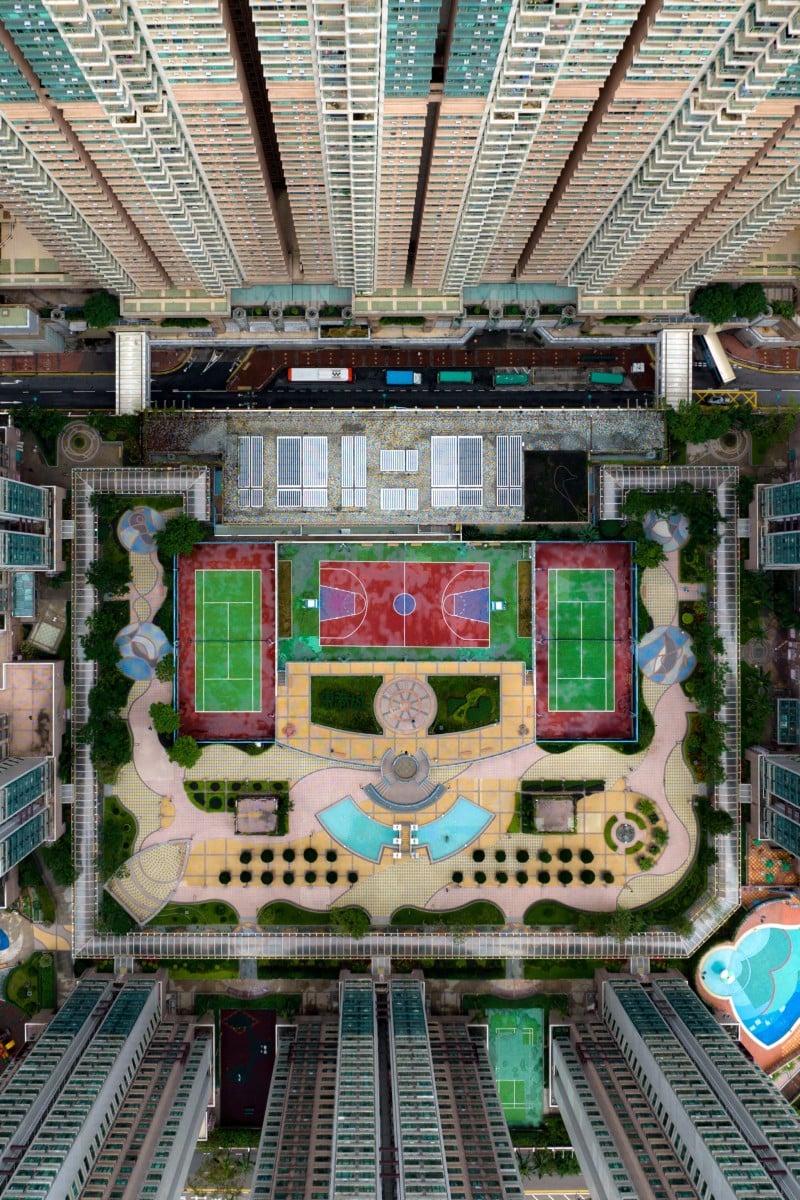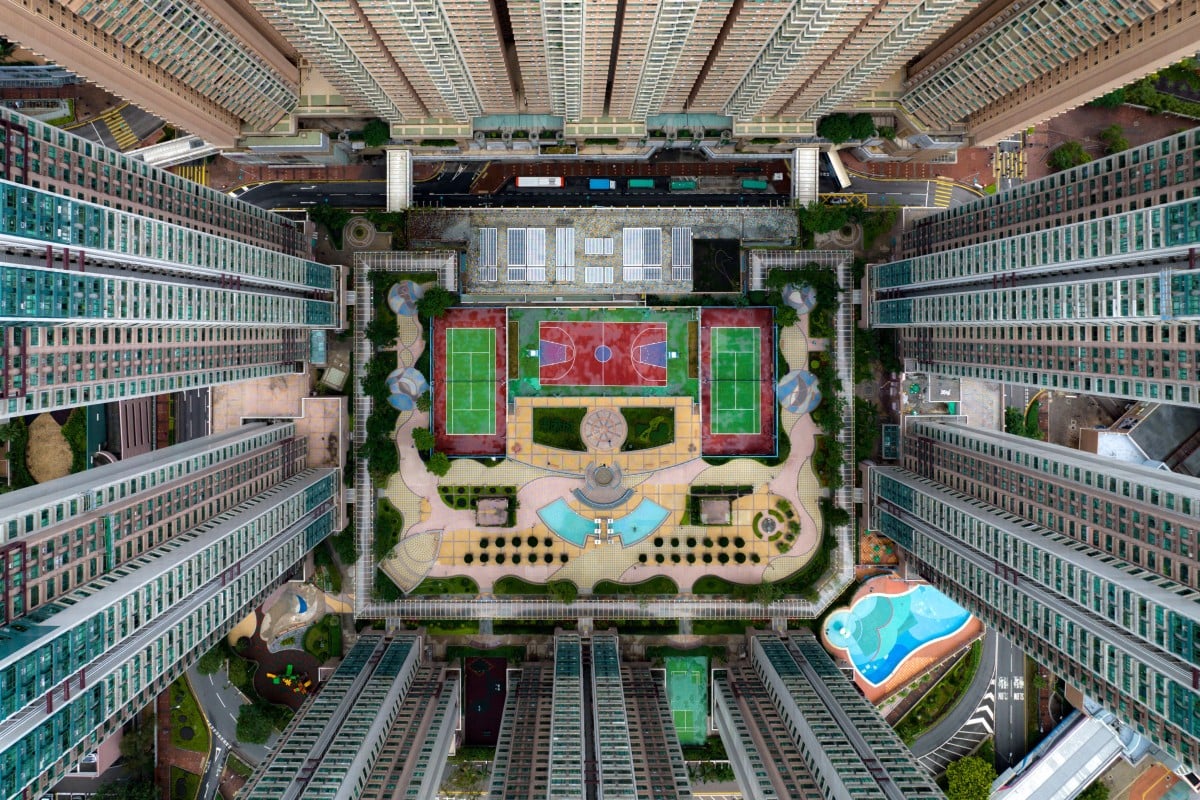
Court beauty: photographer’s aerial shots of 2,549 basketball courts in Hong Kong
Austin Bell talks about the inspiration behind his book ‘Shooting Hoops’, which showcases the city’s vibrant public spaces.
 A basketball court in Tseung Kwan O. Photo: Austin Bell
A basketball court in Tseung Kwan O. Photo: Austin BellEvery week, Talking Points gives you a worksheet to practise your reading comprehension with exercises about the story we’ve written.
Name a school in Hong Kong, and Austin Bell can instantly pull up a photo of its basketball court. The American photographer has built an extensive visual archive in his quest to document all 2,549 basketball courts across the city.
Through aerial photography, he transforms these everyday spaces into striking mosaics.
Bell’s fascination began in 2017 when he visited Choi Hung Estate’s iconic court. Mesmerised by its vivid hues, he returned to Hong Kong two years later with a mission: photograph every basketball court in the city.
His search became a scavenger hunt to unveil hidden corners of Hong Kong that even long-time residents might not recognise.
How award-winning photographer Kelvin Yuen captures stunning landscapes
“I want to show people – whether they’ve lived here all their lives or have never been – that there’s a side of Hong Kong they haven’t seen,” said Bell, who has been travelling full-time since 2018, spending only the winters in Hong Kong.
“We take for granted that we’re literally walking on coloured floors ... Shooting from above really helps highlight that.”
Raised in the United States, Bell grew up surrounded by basketball, but he never expected the sport would become a portal into a city halfway across the world.
According to Bell, American basketball courts often feel like an afterthought, but in Hong Kong, there is intentionality in their design.
“It’s the same attention to detail they put into schools or housing estates. They make them colourful, and there’s thought behind it ... There’s an artistic perspective,” he said, contrasting Hong Kong with a US metropolis.
“In New York City, for example, public housing estates are just brick – boring, drab and old.”
A collection of courts
Earlier this month, Bell self-published Shooting Hoops, a photography book featuring a collection of basketball courts meticulously categorised by district.
“The project was really about reconciling the fact that, OK, maybe I’m not the best photographer in the world, but I was going to be the most comprehensive and create something truly unique,” he said.
This vision led to his most ambitious feat: photographing 475 courts in a single day.
“The sheer act of putting all these courts into one big image – it doesn’t even seem possible,” he said, describing the mosaic featured on the book’s cover.
“At the same time, Hong Kong itself has a reputation for being ... impossible: impossible density, an impossible number of skyscrapers. This was my way of contributing to that.”
One of his favourite courts is at Queen’s Hill Estate in Fanling. Its bold mix of yellow, green and blue, framed by checkerboard patterns, makes it stand out.
By organising the courts by district, he hopes to show the distinct character of each area.
“I love every single district for different reasons. Some of my favourite courts are in Po Lam, and Kwun Tong has so many great ones,” he said.
A community space
Documenting these courts is also a way of preserving the city’s history.
“Nothing in Hong Kong stays the same,” Bell noted. “Basketball courts are one of the best examples of that because they have to be redone every few years.”
He added that basketball courts were significant as more than just sports facilities – they served as community hubs for young people to socialise.
“Courts belong to kids. They’re like the malls ... a place to hang out,” the photographer said.
“And in Hong Kong, that’s even more true because you can’t just go to a friend’s house or throw a party at home easily. These open spaces are what you have. It makes sense that they become the go-to spot after school, even if you don’t play basketball.”
How a plant library helped Hong Kong neighbourhoods be rooted in community
His advice to aspiring photographers is to focus on the everyday details that speak to you.
“Don’t get too caught up in whether a photo is ‘good’ – just make it interesting to you,” he said.
A single photo might not seem compelling on its own. But when you look at 100 of them together, a story might emerge, he added.
“What can you turn into art? A lot of people think basketball courts are mundane, not something artistic. But this project changed that perspective,” he said.
“Maybe for you, it’s something completely different – maybe it’s 7-Eleven cashiers, public toilets, Tin Hau temples or even a recurring character you see around the city. Whatever it is, make it your own.”
To test your understanding of this story, download our printable worksheet or answer the questions in the quiz below.
